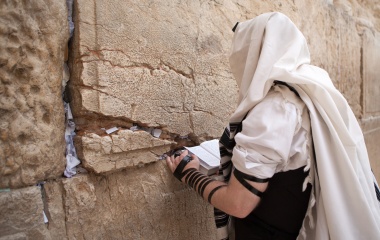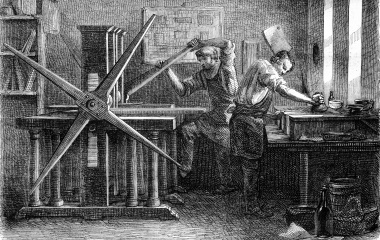
Newton’s third law of motion teaches that for every action, there is an equal and opposite reaction. This law explains why it is much easier to hit a home run if one connects on a fastball than a change-up. With every physical rule having a spiritual corollary, the greater the potential something has for good, the greater the potential it has for evil. The internet is a most amazing tool for the spreading of Torah and bringing people together—and also for spreading hate and tearing people apart. From a Jewish perspective, there is nothing more powerful—and hence, potentially more dangerous—than (the misuse of) Torah.
This is a theme we see often in masechet Yoma. Many of the preparatory steps in readying the kohen gadol for the special day of Yom Kippur were made necessary by the ignorance of many of the high priests—people who received their positions for all kinds of reasons, save for merit. Some bought their positions, and some were Sadducees who did not accept the rabbinic understanding of how the service was to be done. There was good reason to fear that the kohen gadol would not follow the prescribed service on Yom Kippur.
The Yom Kippur service had the ability to gain atonement for the sins of the entire Jewish nation. With such power, any misstep could be deadly[1]. With corruption was rampant, it was rare, if ever, that a high priest survived the year. Our Sages claim that there were over 300 high priests during the Second Temple period, a period the Sages claim lasted 420 years. When one removes the forty years that Shimon Hatzadik served, the eighty years of Yochanan Kohen Gadol[2], and the ten years of Yishmael ben Phabi, that leaves some 300 high priests spread over only 290 years[3], meaning the average length of service was less than one year. Apparently, some were so corrupt that they died even before their first Yom Kippur.
But it was not only the corrupt who had a deeply flawed understating of true religiosity. The second chapter of masechet Yoma opens with a description of the daily Temple service. The first task of the day was the trumat hadeshen, the cleaning of the altar of the ashes from the prior day’s sacrifices. This was carried out before dawn, and is not what one would necessarily consider glamourous work. Hence, “Initially, whoever wishes to remove the ashes from the altar removes them”. Who would want to get up at three in the morning to remove some ashes? On those occasions when more than one kohen would get up early to volunteer, they would race to the top of the altar, “and the kohen who precedes another and reaches within four cubits of the altar would merit” to be chosen. If there was a tie, the kohanim would “put out one or two fingers” (there is little new under the sun) and one of the “officials would call out a number and they would count the fingers” to determine who would get the honour.
Alas, this was no friendly lottery. The Mishna rules that one was not allowed to put out a thumb, as that would make cheating easy! As the numbers wound down, the perceptive kohen could clandestinely either put out or take back a thumb, so that the number would land on them. They might win the lottery, but surely the mitzvah would be tainted.
But that problem is minor compared to what comes next.
One time, the Mishna records, as the kohanim were running up the ramp, one pushed the other off the ramp, breaking his leg. Upon witnessing this, our Sages ordained “that they would remove the ashes of the altar only through a lottery”. How terrible when the desire to do a mitzvah allows one to hurt his fellow Jew! But tragically, the case in the Mishna is child’s play as compared to the case referenced in the Gemara.
“Our Rabbis taught: It once happened that two priests were equal as they ran to mount the ramp, and when one of them came first within four cubits of the altar, the other took a knife and thrust it into his heart” (Yoma 23a).
There is little more dangerous than misplaced religious fervour. Religious teachings have brought so much good to the world, and yet so much killing has been carried out in the name of G-d. As tragic as this murder in the Temple was, the reaction of some was truly appalling. The Gemara relates that the wounded boy’s father came as his son was still convulsing. He declared, “Behold, he is your atonement”. As death can serve as atonement the father declared, while his son was still alive, that the death of his son would serve as an atonement for the people. With people like that, there was much to atone for.
But the father was not yet finished. “My son is still in convulsions, and the knife has not become unclean” (Yoma 23a). Jewish law states that an object that comes in contact with a dead body becomes impure. Remove the knife before death, and the knife remains pure. As his son lay dying, the father was worried about the laws of purity and impurity. Is there any better example to demonstrate the teaching of our Sages that, used improperly, Torah can be “a potion of death” (Taanit 7a)? The Gemara, commenting on this horrific scene, wryly notes, “this teaches you that the ritual purity of utensils was of more concern to them than the shedding of blood[4]”.
G-d gave us a beautiful Torah, a Torat Chaim, a Torah meant to enhance, enrich, and elongate life. When, in the name of Torah, one’s reaction to tragedies is that they are a means to atonement, when the laws of purity become more important than life itself, the power of Torah has become most harmful. And when that happens, we need many Yomas, Days of Atonement, to reflect on what went wrong and how it can be fixed.
[1] This goes a long way towards explaining why Nadav and Avihu were struck while bringing “a foreign fire” in the Mishkan.
[2] And sadly—but perhaps not surprisingly, given the climate of the times—despite those eighty years of service, ultimately, he became a Sadducee (Brachot 29a).
[3] And if we accept the view that Rav Elazar ben Charsum served 11 years, the average drops even more.
[4] Rav Aharon Lichtenstein, zt”l, quoted this story in his call for serious self-reflection by the Religious Zionist community in the wake of the assassination of Yitzchak Rabin, z”l.



